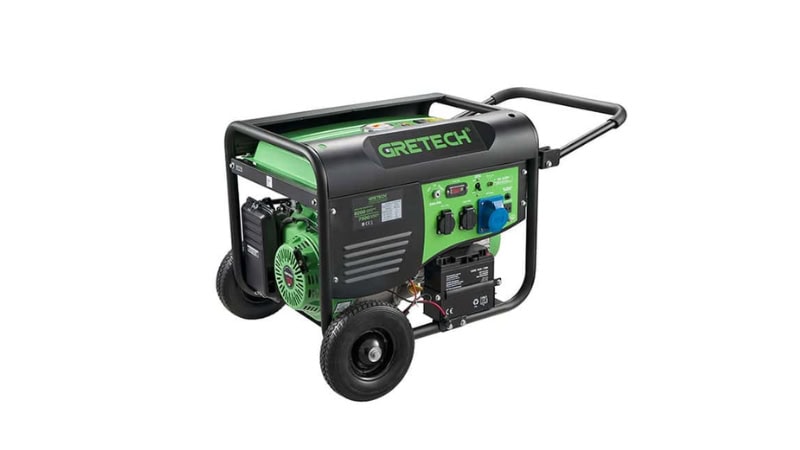
A portable generator is a powerful tool for emergency preparedness, providing essential electricity during a blackout, powering a remote worksite, or making a camping trip more comfortable. However, improper use can lead to severe injury, carbon monoxide poisoning, or even death.
This definitive guide will explain the entire process of using a portable generator, from pre-operation setup to safe shutdown and storage. We’ll cover critical safety guidelines, step-by-step starting instructions, and how to manage your generator power needs effectively. Let’s ensure you’re powered up and protected.
Pre-Operation: Before You Even Start Your Generator
Before you pull the starter cord, proper preparation is crucial. Rushing this stage is the most common cause of user error and accidents.
Read the Manual!

This might seem obvious, but it’s the most frequently skipped step. Your generator’s manual is your most important tool. Every model from every manufacturer has unique features, specifications, and maintenance schedules. The manual contains vital manufacturer’s instructions on the correct type of oil and fuel, the specific load capacity for your model, and troubleshooting guides tailored to your machine. Keep it in a safe, accessible place.
Choosing the Right Location
Where you place your generator is a matter of life and death. The primary risks are carbon monoxide poisoning and fire.
Never Operate a Generator Indoors. This includes garages, basements, crawlspaces, and sheds, even with doors and windows open. Exhaust fumes can seep into your home through vents and cracks.
Keep it Far from Your Home. Maintain a minimum distance of 20 feet from your house, windows, doors, and vents. Ensure the exhaust is directed away from any potential air intake points.
Protect it from the Elements. Operate your generator under a canopy-like structure specifically designed for generators to protect it from rain and snow. Never operate it in wet conditions or touch it with wet hands.
Gathering Your Supplies
Having everything you need on hand before a power outage strikes is key. Your generator kit should include:
- The Correct Fuel: Use the type and octane rating specified in your manual (typically unleaded gasoline or propane). For longer storage, use a fuel stabilizer.
- Heavy-Duty Extension Cords: Use outdoor-rated, grounded (3-prong) extension cords with a wire gauge thick enough for the intended load.
- Personal Protective Equipment (PPE): Safety glasses and work gloves.
- Basic Tools: For initial assembly or maintenance (wrenches, screwdrivers).
- A Fire Extinguisher: Keep a multipurpose, ABC-rated fire extinguisher nearby.
Step-by-Step: How to Start Your Generator
With your supplies gathered and the generator in a safe location, you’re ready to start it up. Follow these steps in order.
Step 1: Check the Oil Level
Just like a car engine, your generator will seize up and be permanently damaged if run without oil. For most new generators, this is the #1 reason they won’t start.
- Place the generator on a level surface.
- Locate the oil dipstick, remove it, and wipe it clean.
- Reinsert the dipstick fully without screwing it in, then remove it again to check the level.
- The oil should be between the low and high marks. If it’s low, top it up with the type of oil recommended in your manual (e.g., 10W-30).
Step 2: Fueling Up
Crucial Safety Warning: Never add fuel to a running generator or one that is still hot. A stray spark or hot engine component can ignite gasoline vapors, causing an explosion or fire. Allow the engine to cool completely before refueling.
- Ensure the generator is off and cool.
- Open the fuel cap slowly to release any pressure.
- Using a funnel, fill the tank with the correct fuel, being careful not to overfill. Leave a little space for expansion.
- Tighten the fuel cap securely.
Step 3: Preparing the Generator
- Disconnect all loads: Ensure all appliances are unplugged from the generator.
- Turn the Fuel Valve On: Locate the fuel valve and turn it to the “On” position.
- Set the Choke: If your generator has a choke, move the lever to the “Start” or “Closed” position. This enriches the fuel mixture for a cold start.
Step 4: Starting the Engine
- For Electric Start Models: Insert the key, turn it to the “On” position, and then press the start button.
- For Recoil Start Models: Firmly grip the handle on the cord. Pull slowly until you feel resistance, then pull rapidly and smoothly to start the engine. Do not yank it violently or let the cord snap back.
Once the engine is running, allow it to warm up for a minute or two. If you used the choke, gradually move it to the “Run” or “Open” position as the engine warms up.
Connecting Appliances and Managing Power
Your generator is running smoothly. Now it’s time to plug in your appliances, but you must do this carefully to avoid overloading the unit.
Understanding Wattage: Don’t Overload It!
Overloading your generator can damage it and the appliances connected to it. You need to understand two types of wattage:
- Running Watts (Rated Watts): The continuous watts the generator can produce.
- Starting Watts (Surge Watts): The extra power an appliance needs to start its motor, often 2-3 times its running watts.
How to Calculate Your Load:
- Make a list of everything you plan to power.
- Find the running and starting watts for each item (check the appliance’s label or manual).
- Add up the running watts of all appliances you will use simultaneously.
- Ensure this total is less than your generator’s running watt capacity.
- The appliance with the highest starting watts must be factored in. Your generator’s surge capacity must be able to handle that initial spike.
*Example: A refrigerator might have 700 running watts but 2,200 starting watts. You must have enough surge capacity for that 2,200-watt demand when it kicks on.*
Tip: Start the generator and plug in the appliance with the highest starting wattage first. Then, add other items one by one.
How to Connect Appliances
- The Right Way (Direct Connection): Use your heavy-duty, outdoor-rated extension cords to plug appliances directly into the generator’s outlets.
- The Better Way (For Whole-Home Circuits): Have a licensed electrician install a transfer switch. This is the only safe way to power your home’s hardwired circuits through the generator. It prevents backfeeding, which is extremely dangerous.
- The WRONG Way (Backfeeding): NEVER plug the generator into a wall outlet in your home. This practice, called “backfeeding,” sends power backward through your home’s wiring and out to the utility grid. It can electrocute utility workers trying to restore power and cause a house fire.
Critical Generator Safety Tips You Can’t Ignore
Safety cannot be overstated when dealing with generators. These points are worth repeating.
Carbon Monoxide: The Invisible Killer
Carbon monoxide (CO) is a colorless, odorless, and tasteless gas produced by the engine that can kill in minutes.
- Outdoors Only, Always. Reiterating the 20-foot rule is essential.
- Install CO Alarms: Place battery-operated or battery-backup carbon monoxide alarms inside your home, outside sleeping areas, and on every level. Test them regularly.
Electrical Safety
- Keep it Dry: Do not use a generator in rain or wet conditions. Protect it from moisture.
- Use Dry Hands: Always ensure your hands are dry before touching the generator or any cords.
- Use GFCI Protection: Many modern generators have GFCI (Ground Fault Circuit Interrupter) outlets for added protection against shock.
Fire Safety

- Cool Before Refueling: We cannot stress this enough. Let the generator cool for at least 15-20 minutes before adding fuel.
- Proper Fuel Storage: Store fuel only in approved containers, away from the generator and any heat sources or living areas.
Shutting Down and Storing Your Generator
When the power is back or you’re finished with your work, a proper shutdown is crucial for the longevity of your generator.
The Proper Shutdown Sequence
- Unplug all appliances from the generator.
- Turn off the engine using the key or switch.
- Turn the fuel valve to the “Off” position. This helps prevent carburetor clogging by running the fuel out of the lines.
Preparing for Long-Term Storage
If you won’t be using the generator for a month or more:
- Stabilize the Fuel: Add fuel stabilizer to the tank and run the generator for 5-10 minutes to circulate the treated fuel through the system. This prevents the fuel from breaking down and forming gum that clogs the carburetor.
- Drain the Fuel (Optional but Recommended): For very long-term storage, you can run the generator until it stalls, ensuring the carburetor is completely empty.
- Change the Oil: It’s best to change the oil while the engine is still warm from running.
- Store Properly: Clean the exterior and store the generator in a clean, dry, and well-ventilated place.
Frequently Asked Questions
Can I run a generator in my garage if I leave the door open?
No. This is extremely dangerous. Carbon monoxide can quickly build up to lethal levels and seep into your home.
How long can a generator run continuously?
It depends on the model and fuel tank size. Most portable gasoline generators need to be refueled every 8-12 hours. Refer to your manual for specific run times and always shut it down for cooling and refueling as needed.
What kind of oil should I use in my generator?
Always follow your manual. For most conditions, a high-quality 10W-30 motor oil is standard. For very hot or cold climates, the manual may recommend a different viscosity.
My generator won’t start. What should I check first?
Use the “F.O.S.S.” acronym: Fuel (is there fresh gas and is the valve on?), Oil (is it at the correct level?), Spark Plug (is it fouled or damaged?), Start Switch (is it in the “on” position?).
How do I choose a generator for my needs?
To choose a generator, first calculate the total wattage of the appliances you need to power. Portable models are great for essentials, while home standby generators automatically power the whole house.
Conclusion
Mastering your generator goes beyond just following steps—it’s about adopting a mindset of safety and responsibility. By prioritizing the critical rules of placement, respecting the power of wattage, and adhering to safe fueling and connection practices, you transform a potential hazard into a lifeline. Let this knowledge be the foundation that allows you to face any outage with confidence, ensuring that when the lights go out, your safety and power remain on.
